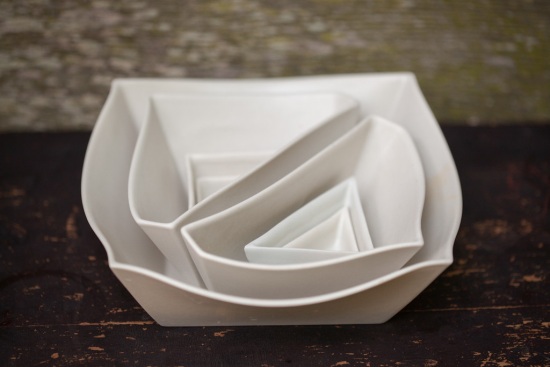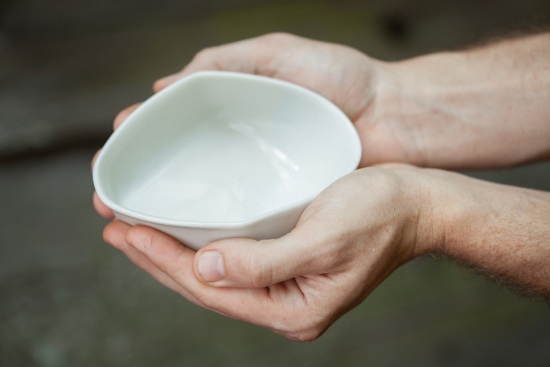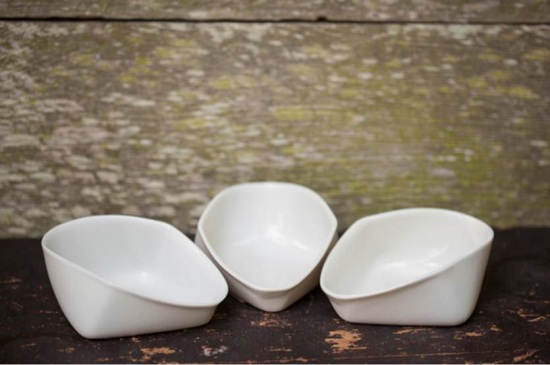
These ice cream bowls were designed to be held in the hand and tilted to your mouth to catch every precious drop. Ingenious! Photo by Shaena Mallett via haand.us.
Here is my interview with Mark:
I understand you have a background in art, and your partner Chris has a background in accounting. Tell me about the moment you decided to launch a ceramics business together. How did that conversation go?
Chris and I have been friends since high school, so we stayed in touch with each other and would try to spend some time together whenever we were geographically close. In the summer of 2011 Chris quit his job with a large CPA firm and I had just finished a two year fellowship at the Penland School of Crafts. I was house sitting for a friend in a beautiful mountain house, and over many Negronis we floated the idea of combining our talents. I think we were both looking for the next big project, and we knew we could work well together because of our many joint barbecue and party throwing adventures. It wasn’t until the fall of 2011 that everything really began to come together, and by January of 2012 Haand was born. It has been an amazing experience, and I find it really helpful to be able to defer to Chris for the business side of things, and I know he is happy to rely on me to take care of the production and new designs. I think it is a major fallacy of studio craftspeople to try to do every aspect of a business- just like any craft, accounting and business management is a skill set that takes years to hone and perfect.
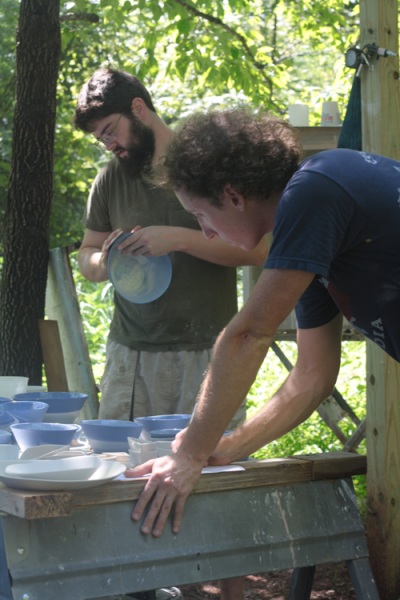
Mark Warren and Chris Spence at work at their NC studio. Photo by Taylor Ghost via designsponge.com.
You implement many sustainable practices in your business. Can you elaborate on what it means to be green, in terms of producing ceramics?
Ceramics is already a fairly green process. Our largest carbon impact comes from propane, our porcelain being shipped from England, and our water consumption. We try to fire as efficiently as possible, and make sure our kilns are filled up as much as possible before firing them, thus cutting down on our propane consumption. Because part of our clay body comes from England, we make sure that all other ingredients are sourced from the Southeast. For water we use exclusively rainwater, partly because our house’s water comes from a dirty spring with lots of red clay, and partly because rainwater has the perfect pH for slip formulation. We believe that part of our responsibility as producers is to ensure our work is ethically created- we focus on working efficiently and using as few impactful resources as possible. As we expand this will continue to be an important focus for Haand.
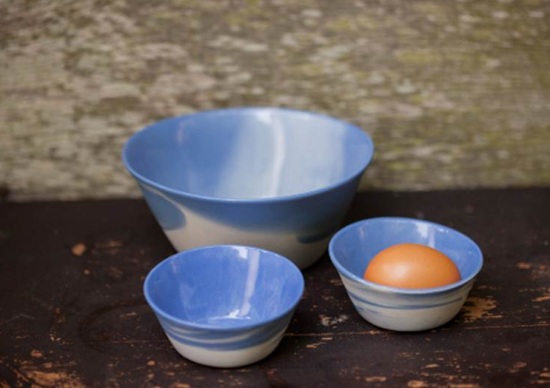
These bowls from Haand’s Cloudware line were inspired by antique Jasperware. Photo by Shaena Mallett via haand.us.
Can you share a little about your design process: where do you find inspiration, and what factors influence your work?
My background is not in design, I went to college for sculpture and religious studies. My process is largely intuitive and material based. I find it helpful to focus on researching the material’s physical properties and look at historical examples of items made with that material. Right now, we work primarily with slip cast porcelain. I started working with this particular process and clay body in 2010, and at this point I have a good idea of what will happen to pieces when subjected to 2300 degrees. I try to design pieces that start out with hard lines and then let the firing change each piece into a unique variation on the original idea.
Your pieces are quite clean and sculptural, with minimal surface decoration. What draws you to these forms?
I have always been drawn to simple, highly functional pieces. I love the unadorned beauty of purely functional things, I often find that highly decorated dinnerware tries to force a narrative on the user. The real narrative should be the delicious food you are (hopefully) about to enjoy with friends and loved ones, and the decoration on the plate should be food you are about to enjoy. That being said, I think there are lots of great craftspeople out there decorating dinnerware, and they can tell a story and share their emotions and thoughts in a really direct way; it’s just never been my interest or impulse.
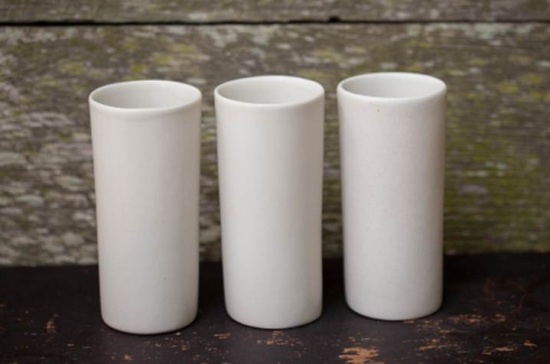
Haand’s Chemist cups come in a rage of sizes for every beverage need. Photo by Shaena Mallett via haand.us.
Which contemporary artists do you most admire?
In ceramics, I love the work of Kirsten Coelho. Her work is inspiring and gorgeous- she makes gorgeous porcelain tableware that looks like it is made out of well used and abused enamelware.
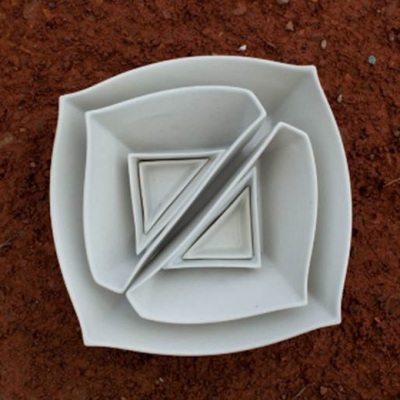
Haand’s “squares and triangles” nesting dishes come in four sizes. Photo by Shaena Mallett via haand.us.
What do you dream of creating, if time and money were not constraints?
I have a lot of ideas that involve collaborating with the scientific community, and I would to begin using techniques and knowledge from the Aerospace industry combined with traditional craft methods and materials. I also would love to use traditional firing methods like wood fired and salt and soda atmospheres on our designs. My favorite part of Haand is the fact that I can legitimately research these topics and if it seems viable, start producing and selling them.
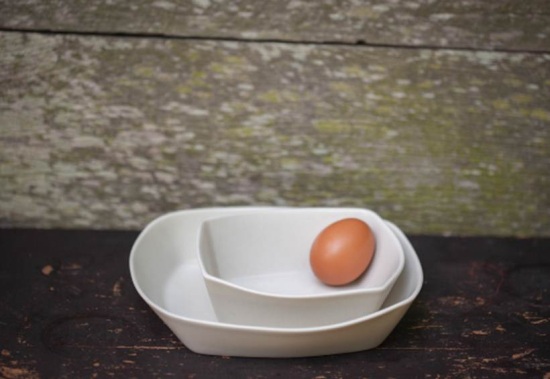
“Oncilla” and “Fossa” plates, part of the Nesting Hunter series from Haand. Photo by Shaena Mallett via haand.us.
How do you envision your company growing and evolving?
Both Chris and I envision Haand eventually being a large volume producer with many employees and craftspeople. We want to start working with other materials, particularly wood and metal. We plan on focussing on products for the home, but Haand has always been an open ended idea, we try to stay flexible and always try new things. Currently we are starting to work on some more architectural, sculptural wall pieces in collaboration with a local artist Leigh Suggs.
And most importantly, where can customers see and purchase your work?
We have work all over the place. Our website is the best place to start: www.haand.us In North Carolina you can see our work in LIGHT: Art and Design in Chapel Hill and at the North Carolina Museum of Art. We also have work in The Getty Museum in LA, Steven Alan carries our work in NYC, and there are a few other online stores that carry our pieces as well.
———
Tamara Leicester is a licensed interior designer and owner of Tamara Heather Interior Design, LLC. She designs casually elegant interiors with an artistic sensibility, often drawing upon the talent of local artists and craftspeople in her work. Dreaming about updating your space? Learn more at tamaraheatherinteriors.com.

